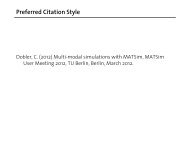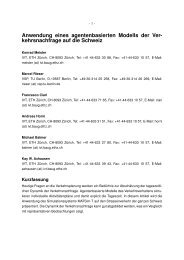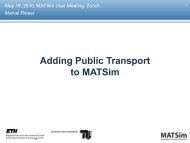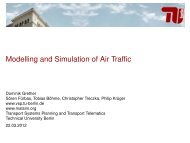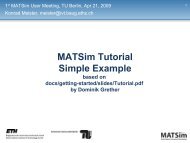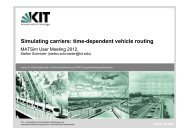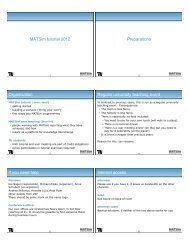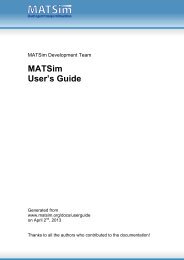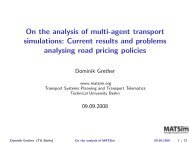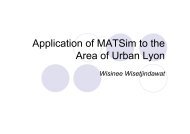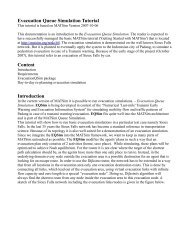LARGE-SCALE PARALLEL GRAPH-BASED SIMULATIONS - MATSim
LARGE-SCALE PARALLEL GRAPH-BASED SIMULATIONS - MATSim
LARGE-SCALE PARALLEL GRAPH-BASED SIMULATIONS - MATSim
Create successful ePaper yourself
Turn your PDF publications into a flip-book with our unique Google optimized e-Paper software.
Chapter 2<br />
The Queue Model for Traffic Dynamics<br />
2.1 Introduction<br />
A traffic flow simulation consistent with the multi-agent approach discussed in Chapter 1 and<br />
e.g., by [67, 65] should fulfill the following conditions:<br />
The model should have individual travelers/vehicles 1 in order to be consistent with all<br />
agent-oriented learning approaches.<br />
The model should be simple in order to be comparable with static assignment and in<br />
order to allow concentration on computational issues rather than modeling issues.<br />
This includes the ability of task parallelization into software.<br />
The model should be computationally fast so that scenarios of a meaningful size can be<br />
run within acceptable periods of time.<br />
For the work presented here, a fourth condition is also stated:<br />
The model should be somewhat realistic so that meaningful comparisons to real-world<br />
results can be made.<br />
These conditions make the use of existing software packages, such as DynaMIT [17],<br />
DYNASMART [18], or TRANSIMS [59], difficult since these software packages are already<br />
fairly complex and complicated. An alternative is to select a simple model for large scale microscopic<br />
network simulations, and to re-implement it. If one wants queue spill-back, there are<br />
essentially two starting points: queueing theory, and the theory of kinematic waves.<br />
In queueing theory, one can build networks of queues and servers [76, 14, 73]. Packets<br />
enter the network at an arbitrary queue. Once in a queue, they wait typically in a first-in firstout<br />
(FIFO) queue until they are served; servers serve queues with a given rate. Once the packet<br />
is served, it will enters the next queue.<br />
This can be directly applied to car/vehicle traffic, where packets correspond to vehicles,<br />
queues correspond to links, and serving rates correspond to link capacities. The decision of a<br />
vehicle about which link to enter after it is served at an intersection is given by the vehicle’s<br />
route, which is a list of nodes (intersections) that a vehicle must pass through during its trip.<br />
1 Terminology: In multi-agent simulations, agents are units. The traffic flow simulation described here simulates<br />
the vehicle traffic. The agents in the traffic model are vehicles. Agents and vehicles are used on reciprocal<br />
terms. Although a vehicle is an agent of transmission and is generally not restricted to a “car”, it represents a car<br />
and accordingly a driver who is of person-type throughout this thesis.<br />
5



